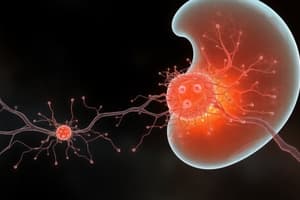Podcast
Questions and Answers
Which germ layer primarily forms the gastrointestinal tract?
Which germ layer primarily forms the gastrointestinal tract?
- Epiderm
- Ectoderm
- Mesoderm
- Endoderm (correct)
What develops from the upper gastrointestinal tract?
What develops from the upper gastrointestinal tract?
- Pancreas
- Lungs (correct)
- Liver
- Kidneys
Which of the following is NOT formed by the mesoderm?
Which of the following is NOT formed by the mesoderm?
- Nervous system (correct)
- Bones
- Skin
- Muscles
What is formed by the ectoderm, in addition to skin and hair?
What is formed by the ectoderm, in addition to skin and hair?
Which of the following organs is formed by the endoderm?
Which of the following organs is formed by the endoderm?
What forms the outer layer of skin?
What forms the outer layer of skin?
Which germ layer forms the skeletal system?
Which germ layer forms the skeletal system?
Which of the following is formed by the mesoderm?
Which of the following is formed by the mesoderm?
Flashcards are hidden until you start studying
Study Notes
Embryogenesis and Germ Layers
- Gastrulation: a process in early embryogenesis that forms three primary germ layers: endoderm, mesoderm, and ectoderm
- Each germ layer gives rise to specific structures in the body
Endoderm
- Forms the gastrointestinal tract, represented as a tube with holes at both ends
- Develops into:
- Lungs, which branch out from the upper gastrointestinal tract
- Liver
- Pancreas, located in the abdomen
- Esophagus, stomach, small intestines, and large intestines
Mesoderm
- Forms:
- Skin layers (inner layers)
- Muscles and bones, including cardiac muscle
- Kidneys and bladder, located in the abdomen and pelvis
- Ovaries or testes
Ectoderm
- Forms:
- Outer layer of skin
- Skin-related items such as sweat glands and hair
- Nervous system, which is a surprising derivative of the ectoderm
Studying That Suits You
Use AI to generate personalized quizzes and flashcards to suit your learning preferences.



